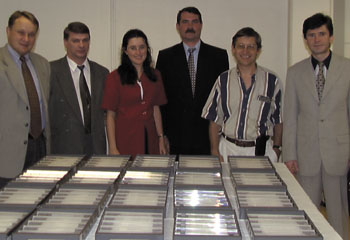
As a result of the technological problems to be solved and the global level of participation in the major experiments at CERN’s LHC proton collider, supply and manufacturing has to explore unusual sources.
From the outset, the design of the major CMS experiment at the LHC foresaw calorimetry measuring the energy of the particles emerging from the collisions as of prime importance. Both the electromagnetic and the hadronic calorimeters are inside the solenoid that supplys the detector’s magnetic field, with the electromagnetic calorimeter (ECAL) immediately outside the inner tracker.
The ECAL will use lead tungstate crystals to pick up the emerging photons, which could provide useful signatures of new particles. With its strong photon absorption, lead tungstate makes a compact, and so cheaper, detector. Displaying the international flavour of the CMS collaboration, production of the approximately 80 000 lead tungstate crystals will be shared between the Bogoroditsk Techno-Chemical Plant in Russia and the Shanghai Institute of Ceramics in China.
After four years of active R&D, a preproduction phase has just begun in Russia, where 6000 crystals will be grown in mass-production conditions. This continues until the middle of next year. The goal of this preproduction phase is to tune the production conditions for a maximum yield of good-quality crystals. The first three batches, together amounting to 400 crystals, were delivered to CERN on schedule late last year. The quality of the first crystals received is already greater than the most optimistic expectations. The crystals are very clear, colourless, highly transparent and with an exceptionally fast response time (more than 97% of the light appears within 100 ns). The light yield is in excess of eight photoelectrons per mega electron volt.
All LHC detector components will have to contend with a harsh environment owing to the thousands of secondary particles that are produced by each collision. “Radiation hardness” is therefore of prime importance. Initial measurements of the CMS ECAL crystal’s radiation hardness is well within the specified range.
Growing large crystals is not straightforward, but the growth yield has also been very high already very close to the target of 75%. This was made possible through a concerted R&D effort supported by CERN and the ISTC (International Science and Technology Centre) in which several groups of the CMS ECAL community, particularly those from Minsk and CERN, have actively participated. (The ISTC is the international scheme set up in 1991 to diversify and reorient the effort that was formerly channelled into Soviet military applications.)
During this initial period the basic mechanisms underlying the phenomena responsible for the light production and the radiation damage in this crystal have been studied systematically.
This was a vital step towards improving crystal quality, first at a small scale and progressively at the mass production scale, at a level that meets the very tight specifications imposed by the LHC running conditions.





